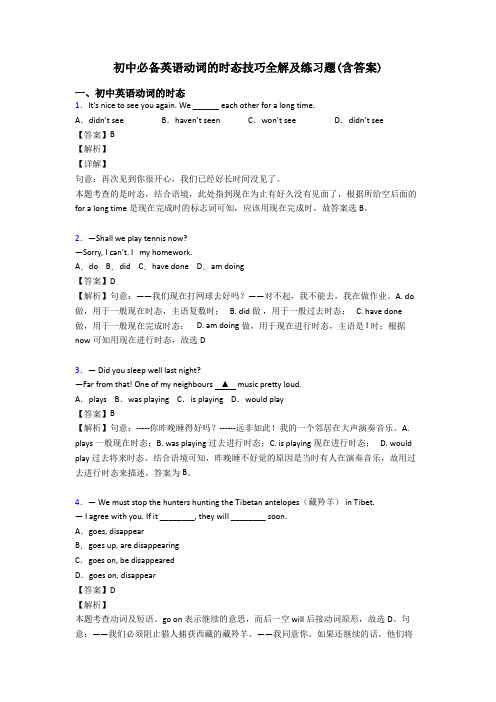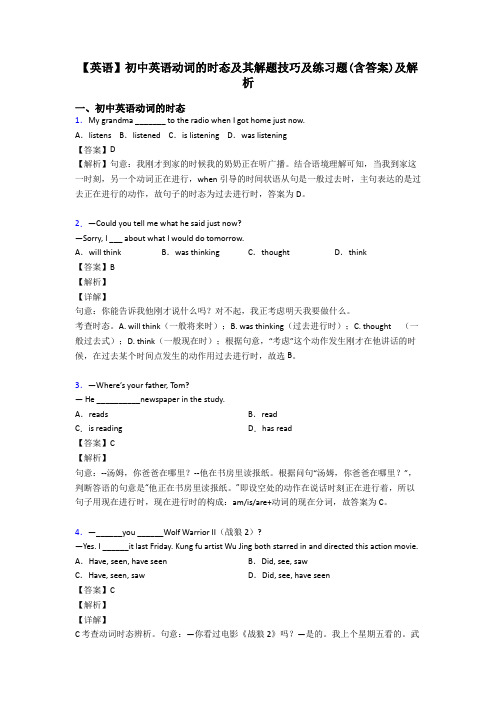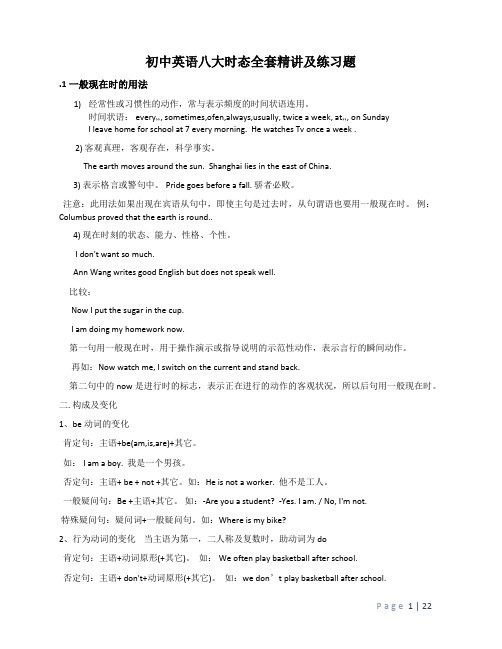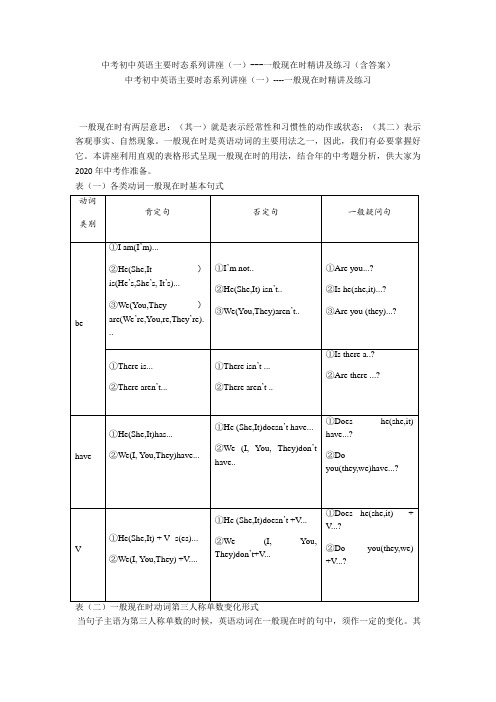初中英语时态讲解及练习(含答案)培训资料
初中必备英语动词的时态技巧全解及练习题(含答案)

初中必备英语动词的时态技巧全解及练习题(含答案)一、初中英语动词的时态1.It’s nice to see you again. We ______ each other for a long time.A.didn’t see B.haven’t seen C.won’t see D.didn’t see【答案】B【解析】【详解】句意:再次见到你很开心,我们已经好长时间没见了。
本题考查的是时态,结合语境,此处指到现在为止有好久没有见面了,根据所给空后面的for a long time是现在完成时的标志词可知,应该用现在完成时,故答案选B。
2.—Shall we play tennis now?—Sorry, I can’t. I my homework.A.do B.did C.have done D.am doing【答案】D【解析】句意:——我们现在打网球去好吗?——对不起,我不能去,我在做作业。
A. do 做,用于一般现在时态,主语复数时; B. did做,用于一般过去时态; C. have done 做,用于一般现在完成时态; D. am doing做,用于现在进行时态,主语是I时;根据now可知用现在进行时态,故选D3.— Did you sleep well last night?—Far from that! One of my neighbours ▲ music pretty loud.A.plays B.was playing C.is playing D.would play【答案】B【解析】句意:-----你昨晚睡得好吗?------远非如此!我的一个邻居在大声演奏音乐。
A. plays一般现在时态;B. was playing 过去进行时态;C. is playing 现在进行时态; D. would play过去将来时态。
结合语境可知,昨晚睡不好觉的原因是当时有人在演奏音乐,故用过去进行时态来描述,答案为B。
初中英语时态讲解及练习-(全)

一般将来时
构成:①will,shall+动词原形,其中shall只用 于第一人称。②be going to +动词原形,表 示主观打算,按计划,安排要发生的事情。 ③be to +动词原形,表示客观安排 ④ be about to +不定式,意为马上要做某事,正 要做某事。⑤某些动词,可用进行时态表 将来,如come, go, arrive, leave。⑥在时间 状语从句和条件状语从句中,主句用一般 将来时(will+动词原形),从句中用一般现 在时表将来。⑦一般现在时可表示按时间 表发生的将来的动作(限start, begin, arrive, end, close, leave---等表示开始或移动意义的 词)
什么情况下用?
①表示经常或习惯性的动作或存在 的状态。②表示主语通常的能力、 兴趣爱好、和性格特征。③表示客 观的事实或真理。④表示按照时刻 表或已经计划安排好的将来行为。 (只限于是go, come, leave, arrive, begin, start, take off, stop, be等表示开 始或移动意义的词。)⑤在时间状 语从句和条件状语从句中,主句用 一般将来时(will+动词原形),从句
6. 用法:现在进行时表示
1)、现在(说话的瞬间)正在进行或发生 的动作,强调“此时此刻”。
E.g. He is reading . They are talking now. 2)、当前一段时间内的活动或现阶段正在 进行的动作。 E.g. They are working these days. 3)、 某些动词的现在进行时,表预定的计 划或即将发生的动作。 E.g I am coming.
1. He______(be, am, is, are) a teacher at No. 2 Middle School. 2. He______(have, has) classes in the afternoon. 3. He______(get, gets) up at half past six every morning. 4. He always _____(come, comes ) to school on time. 5. He ______(study, studies) very hard at his lesson. 6. One and two _____(be, is, are) three. 7. Blue and yellow _____(make, makes) green. 8. The earth _____(move, moves) round the sun. 9. I will go there if I ____( be, will be, am, is, are) free tomorrow.
牛津上海版8A语法时态综合讲解及练习(有答案)

语法:时态语态综合初中阶段考查8种时态,分别是一般现在时、一般过去时、一般将来时、现在进行时、过去进行时、现在完成时、过去完成时和过去将来时。
今天我们涉及6个时态,分别是一般现在时、一般过去时、一般将来时、现在进行时、过去进行时和现在完成时。
英语的语态分为主动语态和被动语态,主动语态表示主语是动作的执行者。
被动语态表示主语是动作的承受者,目前中考主要考查一般现在时、一般过去时、一般将来时和现在完成时这四种时态的被动语态以及含情态动词的被动语态。
只有及物动词才有被动语态。
它的基本结构为:be动词+及物动词的过去分词。
所有的时态变化在be动词上。
动词时态:动词语态注意以下几种被动语态的特殊情况:一.被动语态中不定式要还原Let/make/see/hear/watch sb. do sth.----- sb. be let/made/seen/heard/watched to do sth.My mother made me look after the little sister yesterday.----I was made to look after the little sister by my mother yesterday.二.有些动词没有被动语态。
(及物动词才有被动语态)1) 不及物动词或动词短语无被动语态:appear, die,disappear, end (vi. 结束), fail, happen, last, lie, remain, sit, spread, stand break out, come true, fall asleep, keep silence, lose heart, take place.2) 系动词无被动语态:appear, be,become, fall, feel, get, grow, keep, look, remain, seem, smell, sound, stay, taste, turn3) 不能用于被动语态的及物动词或动词短语:fit, have, hold, marry, own, wish, cost, notice, watch,agree with, arrive at / in, shake hands with, succeed in, suffer from, happen to, take part in, walk into, belong to4) 系动词无被动语态:appear, be,become, fall, feel, get, grow, keep, look, remain, seem, smell, sound, stay, taste, turn5) 当宾语是不定式时,很少用于被动语态。
【英语】初中英语动词的时态及其解题技巧及练习题(含答案)及解析

【英语】初中英语动词的时态及其解题技巧及练习题(含答案)及解析一、初中英语动词的时态1.My grandma _______ to the radio when I got home just now.A.listens B.listened C.is listening D.was listening【答案】D【解析】句意:我刚才到家的时候我的奶奶正在听广播。
结合语境理解可知,当我到家这一时刻,另一个动词正在进行,when引导的时间状语从句是一般过去时,主句表达的是过去正在进行的动作,故句子的时态为过去进行时,答案为D。
2.—Could you tell me what he said just now?—Sorry, I ___ about what I would do tomorrow.A.will think B.was thinking C.thought D.think【答案】B【解析】【详解】句意:你能告诉我他刚才说什么吗?对不起,我正考虑明天我要做什么。
考查时态。
A. will think(一般将来时);B. was thinking(过去进行时);C. thought (一般过去式);D. think(一般现在时);根据句意,“考虑”这个动作发生刚才在他讲话的时候,在过去某个时间点发生的动作用过去进行时,故选B。
3.—Where’s your father, Tom?— He __________newspaper in the study.A.reads B.readC.is reading D.has read【答案】C【解析】句意:--汤姆,你爸爸在哪里?--他在书房里读报纸。
根据问句“汤姆,你爸爸在哪里?”,判断答语的句意是“他正在书房里读报纸。
”即设空处的动作在说话时刻正在进行着,所以句子用现在进行时,现在进行时的构成:am/is/are+动词的现在分词,故答案为C。
(英语)初中英语动词的时态常见题型及答题技巧及练习题(含答案)

(英语)初中英语动词的时态常见题型及答题技巧及练习题(含答案)一、初中英语动词的时态1.I _______ him the good news as soon as he _______ back.A.will tell, comes B.told, comesC.will tell, will come D.tell, come【答案】A【解析】句意:他一回来,我就告诉他这个好消息。
as soon as“一……就……”,引导的时间状语从句,用一般现在时,主句用一般将来时。
第二空主语he是第三人称单数,故谓语用第三人称单数comes。
故选A。
2.—Shall we play tennis now?—Sorry, I can’t. I my homework.A.do B.did C.have done D.am doing【答案】D【解析】句意:——我们现在打网球去好吗?——对不起,我不能去,我在做作业。
A. do 做,用于一般现在时态,主语复数时; B. did做,用于一般过去时态; C. have done做,用于一般现在完成时态; D. am doing做,用于现在进行时态,主语是I时;根据now可知用现在进行时态,故选D3.—Where’s your father, Tom?— He __________newspaper in the study.A.reads B.readC.is reading D.has read【答案】C【解析】句意:--汤姆,你爸爸在哪里?--他在书房里读报纸。
根据问句“汤姆,你爸爸在哪里?”,判断答语的句意是“他正在书房里读报纸。
”即设空处的动作在说话时刻正在进行着,所以句子用现在进行时,现在进行时的构成:am/is/are+动词的现在分词,故答案为C。
4.—There are so many swimmers swimming in the swimming pool.—Yes, and sixty percent _ children.A.is B.are C.was D.were【答案】B【解析】句意:——在游泳池里有那么多游泳者正在游泳。
中考英语备考:初中英语主要时态系列讲座(三)----一般将来时与过去将来时精讲及练习(含答

中考初中英语主要时态系列讲座(三)----一般将来时与过去将来时精讲及练习(含答案)中考初中英语主要时态系列讲座(二)----一般将来时与过去将来时精讲及练习考点一:动词一般将来时的用法一般将来时,有两层含义:其一,表示将要发生的动作或存在的状态;其二,表示打算、计划或准备要做的某事。
为了直观地掌握一般将来时的用法,下面我们用表格的形式来表达。
表(一)一般将来时的表示类型及主要句式表(三)一般将来时的主要用法(天津)---What is your plan for next weekend,Lingling?----I volunteer work in the museum.A. was doingB. didC. have doneD. am going to do【析】正确答案D。
句意是:玲玲,下周末的安排是什么?我打算到博物馆去作志愿者。
根据上文的next weekend(下周末)可知,玲玲的回答是指下周的打算,所以用一般将来时,因此,正确答案为D。
【典型考例】(四川内江)---Have you watched the new movie,Joe?---No,I________ it with my sister this evening.A.watch B.are watching C.watched D.will watch【析】正确答案:D。
句意是:乔,你看了这部新电影吗?没有。
我今晚将和我妹妹一起去看。
根据本句末的时间状语this evening可知,看新电影这动作是将来要做的事情,因此动词使用一般将来时。
所以,正确答案为D。
【典型考例】(天津)----Could you tell me for the fruit?----By paying over the Internet.A. how much will I payB. how much I will payC. how will I payD. how I will pay【析】正确答案D。
初中英语八大时态全套精讲及练习题(附答案)

初中英语八大时态全套精讲及练习题.1 一般现在时的用法1)经常性或习惯性的动作,常与表示频度的时间状语连用。
时间状语: every…, sometimes,ofen,always,usually, twice a week, at…, on SundayI leave home for school at 7 every morning. He watches Tv once a week .2) 客观真理,客观存在,科学事实。
The earth moves around the sun. Shanghai lies in the east of China.3) 表示格言或警句中。
Pride goes before a fall. 骄者必败。
注意:此用法如果出现在宾语从句中,即使主句是过去时,从句谓语也要用一般现在时。
例:Columbus proved that the earth is round..4) 现在时刻的状态、能力、性格、个性。
I don't want so much.Ann Wang writes good English but does not speak well.比较:Now I put the sugar in the cup.I am doing my homework now.第一句用一般现在时,用于操作演示或指导说明的示范性动作,表示言行的瞬间动作。
再如:Now watch me, I switch on the current and stand back.第二句中的now是进行时的标志,表示正在进行的动作的客观状况,所以后句用一般现在时。
二. 构成及变化1、be动词的变化肯定句:主语+be(am,is,are)+其它。
如: I am a boy. 我是一个男孩。
否定句:主语+ be + not +其它。
如:He is not a worker. 他不是工人。
中考初中英语主要时态系列讲座(一)---一般现在时精讲及练习(含答案) (2)

中考初中英语主要时态系列讲座(一)---一般现在时精讲及练习(含答案)中考初中英语主要时态系列讲座(一)----一般现在时精讲及练习一般现在时有两层意思:(其一)就是表示经常性和习惯性的动作或状态;(其二)表示客观事实、自然现象。
一般现在时是英语动词的主要用法之一,因此,我们有必要掌握好它。
本讲座利用直观的表格形式呈现一般现在时的用法,结合年的中考题分析,供大家为2020年中考作准备。
表(一)各类动词一般现在时基本句式当句子主语为第三人称单数的时候,英语动词在一般现在时的句中,须作一定的变化。
其变化规则与名词单数变复数相同。
具体见下表:表(三)一般现在时常用时间状语由于一般现在时主要表示经常性或习惯性的动作,所以,在句中就有一些表示性惯性或经常性的副词或短语去说明动作的经常性或习惯性。
现将于一般现在时相关的这些副词或短语,归纳在表中,供大家掌握。
表(四)一般现在时的主要用法(北京) Sam ______with his friends every weekend.A. skatesB. is skatingC. has skatedD. was skating【析】正确答案:A 。
句意是:每个周末,山姆都和朋友们一起滑冰。
根据句末的频度副词短语every weekend(每周末)可知,句子表示的动作具有经常性,所以动词应使用一般现在时。
【典型考例2】(青海)----What did you learn in geography yesterday?----I learned that the sun _____ in the east.A.was risingB.risesC.rose【析】正确答案:B。
句意是:昨天的地理课上你学了什么?我学了太阳从东边升起来。
太阳从东边升起来,表示的客观事实,一种自然现象,所以,句中的动词应使用一般现在时,因此,正确答案为B。
【典型考例3】(山东临沂)---I'm getting hungry. Do you know where we can get some good food?--- Of course! There ____________ a restaurant around the comer.A. will beB. wasC. is【析】正确答案:C。
- 1、下载文档前请自行甄别文档内容的完整性,平台不提供额外的编辑、内容补充、找答案等附加服务。
- 2、"仅部分预览"的文档,不可在线预览部分如存在完整性等问题,可反馈申请退款(可完整预览的文档不适用该条件!)。
- 3、如文档侵犯您的权益,请联系客服反馈,我们会尽快为您处理(人工客服工作时间:9:00-18:30)。
时态1. 一般现在时●形式:do does(单数第三人称)●意义:一般现在时表示客观的、普遍性的真理以及经常性的事件。
●用法:A) 表示现在发生的动作、情况、状态和特征。
B) 经常性、习惯性动作。
e.g.:He always helps others. (他总是帮助别人。
)He often goes to the gym.C) 客观事实和普遍真理。
尤其要注意,如果前后文不是一般现在时,则无法保持主句、从句时态一致。
e.g.: The sun rises in the east and sets in the west.Knowledge is power.●这一用法场合一些表动作频率的时间副词连用:1). 表示肯定的频率副词:always, frequently, usually, sometimes, generally, occasionally, often etc.2). 表示否定的频率副词:never, seldom, rarely etc.➢这些副词的位置:在Be动词后,实义动词前。
e.g. He is always late.2. 一般过去时●形式:did●意义:一般过去时表示在过去的某一特定时间发生和结束的活动或情况。
●用法:A) 表示过去某个时间发生的动作或情况。
e.g.: I saw him in the library yesterday morning. (有特定的时间状语)➢y esterday, yesterday evening, last night/month/spring/year, the night before last(前天晚上),three days/months/years ago, in 1999 etc.。
这些时间状语之前不用加介词。
B) 表示过去习惯性动作,一直持续或反复发生的动作,此时可与表示拼读的时间副词连用。
e.g.: I slept for eight hours last night. (表示在过去某一段时间内持续的动作,但这动作现在已经结束了)3. 一般将来时●形式:will/shall do或be going to do●意义:一般将来时表示在未来的某个时间将要发生的某个动作或状态。
●学明白一般将来时要理解的一下三个至关重要的概念:1) 预测,表示说话人认为将来会发生某件事。
2) 事先计划:说话人在头脑里已经做出决定将来要做某件事。
3) 意愿:说话人既不是预计某事会发生,也不是预先经过考虑决定将做某事,而是在说话的时刻立即做出决断表明他将做某事。
●用法:A) 用来预测,表示预测,或说估计将来要发生某事,可用 will 或be going to。
e.g.: According to the weather report, it will be windy tomorrow.B) 表示“打算去...,要...”时,可用be going to do。
e.g.: This is just what I am going to say.C) 表示“将要、正要”时,可用be about to do。
强调近期内或马上要做的事。
e.g. Do not worry, I am about to make a close examination on you. (别担心,我马上就给你做一次仔细的检查。
)D) "be to do"的5种用法:a) 表示“按计划、安排即将发生某事或打算做某事”。
例:She is to be seen in the lab on Monday.(星期一你准会在实验室见到她。
)b) 该做或不该做的事情(语气上接近于should, must, ought to, have to),表示一种命令、规劝性语气。
e.g.:You are to go to bed and keep quiet, kids. Our guests are arriving in less than 5 minutes.(孩子们,你们必须上床睡觉,不准吵闹。
我们的客人5分钟之内就要到了。
)c) 能或不能发生的事情(接近can, may)例:How am I to pay such a debt?(我怎么可能还得起这么大的一笔债呢?)d) 不可避免将要发生的事情,后来将要发生的事情。
e.g.:I assure you that the matter _______ as quickly as possible. Have a little patience.A. will be attendedB. will be attended toC. is attendedD. is attended towill be attended to关键的一点是:attend表示“处理,解决”时是不及物动词,必须与to连用。
另外,从上下文看,事情显然尚未解决,所以应该用将来时的被动语态。
答案是B。
e) 用于条件从句“如果……想,设想”(接近if ……want to,或if ……should)e.g.:Greater efforts to increase agricultural production must be made if food shortage ____________ avoided.A is to beB can beC will beD has been答案是A. is to be。
全句的意思是:“如果要避免食品短缺,就必须作出更大努力来增加农业产量。
”➢表预测时,我们可以用will 或be going to。
但两者还存在以下两点区别:1) 用be going to 特别是意指根据目前的明显迹象来推断某件事将要发生。
will则只是表明说话人认为或相信某件事将要发生。
2) be going to 通常用来表示说话人与其所说的时间马上或在相当近的将来就要发生。
而will所表示的动作发生的时间可近可远。
a. Look at those black clouds! It's going to rain.b. I feel terrible. I think I'm going to be sick.c. John is going to fall into that hole!d. Oh, my dear! They're going to bump against that tree!e. You look very pale. I am sure you are going to get sick.一般时态练习一、用动词的适当形式填空1.Vegetarians(素食者) (not, eat)meat.2.An atheist(无神论者) (not, believe)in God.3.Constant dripping(滴水) (wear)away a stone.4.John (always, not, go)to school late. That is tosay, he (sometimes, attend)school late. He (be, generally)a good student. He (be, always)ready tohelp others.5.If it (rain)tomorrow, we'll have to put off oursports meet.6.Look!Here (come)your boyfriend!7.Mozart (write)more than 600 pieces of music.8.I (be)very tired last night, so I (go)to bed early.9. you (go)anywhere on Labor Day?10.When I was young, I (want)to be a bus driver.答案:1.don't eat2.doesn't believe3.wears4.doesn't always go, sometimes attends, is generally, isalways5.rainses7.wrote8.was,went9.Did,go10.wanted●形式:be doing: am/is/are+doing.(是助动词,没有“是”的意思).●意义:强调在现在这个时间点,某项活动正在发生。
●用法:A) 表示说话此刻正在进行。
e.g.: What program are you watching?I am studying English.B) 表示现阶段正在持续的动作。
这是进行时态表示的是一个一般性的活动,在说话时刻这个动作并不一定正在发生。
e.g.: These days I am translating a book.C) 表示最近的将来一定的安排。
通常含有“计划”、“安排做”之意。
e.g.: I am taking a makeup test tomorrow.D) 现在进行时常与always, forever, continually, constantly 等连用,往往表示抱怨、厌烦、不合理或使人不愉快的事。
e.g.: Jack is always borrowing money and forgetting to pay you back. Jack常常借钱忘还。
How come Joe is always groaning about things?Joe为什么总是在抱怨?5. 过去进行时●形式:be doing: was/were doing●意义:强调在过去这个时间点,某项活动正在发生。
●用法:A) 用来描述一个过去特定的时刻正在发生的事情。
e.g.: I was discussing my thesis with my director at this time last night.(特定时刻)B) 过去进行时还常常和一般过去时配合使用。
此时,过去进行时通常表示一个历史较长的体现“背景”的动作或状态;而一般过去时则表示此“背景”下发生的,短暂的动作或状态。
过去进行时动作先发生,一般过去时动作后发生。
e.g. I was telephoning Harry when she arrived.(在五打电话过程中,她到了。
先telephone,后arrive)I telephoned Harry when she arrived.(她回来之后,我才打电话。
